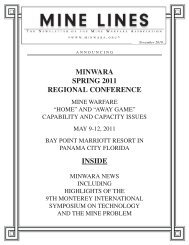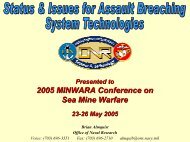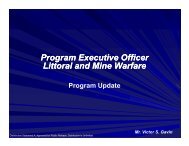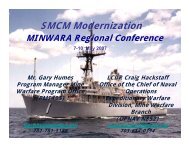Future Unmanned Systems for Mine Warfare - MINWARA - The Mine ...
Future Unmanned Systems for Mine Warfare - MINWARA - The Mine ...
Future Unmanned Systems for Mine Warfare - MINWARA - The Mine ...
You also want an ePaper? Increase the reach of your titles
YUMPU automatically turns print PDFs into web optimized ePapers that Google loves.
Shaping the <strong>Future</strong> of Naval <strong>Warfare</strong> with <strong>Unmanned</strong> <strong>Systems</strong><br />
<strong>Future</strong> <strong>Unmanned</strong> <strong>Systems</strong><br />
<strong>for</strong> <strong>Mine</strong> <strong>Warfare</strong><br />
26 May 2005<br />
Naval Surface <strong>Warfare</strong> Center – Panama City<br />
Naval Sea <strong>Systems</strong> Command<br />
Dr. Ace Summey
Commitments to <strong>Unmanned</strong> <strong>Systems</strong><br />
“Now it is clear the military does not have enough unmanned vehicles. vehicles.<br />
We're entering<br />
an era in which unmanned vehicles of all kinds will take on greater greater<br />
importance -- in<br />
space, on land, in the air, and at sea.” President George W. Bush, Citadel Speech, 11 Dec 2001<br />
“<strong>The</strong> U.S. military has little choice but to pursue integrated battlefield battlefield<br />
robotics – autonomous<br />
machines working together that can replace humans <strong>for</strong> many warfighting warfighting<br />
functions. If the U.S.<br />
doesn’t pursue the fielding of thinking, lethal machines, potential potential<br />
adversaries will. It is not a<br />
question of how it will be done, but of when and by whom.” Project ALPHA (APL/JHU)<br />
“<strong>Unmanned</strong> Vehicles. <strong>The</strong> technology and cost<br />
risks are great, but the potential is high to eventually<br />
reduce manpower costs and risks to U.S. service<br />
personnel and improve our position on the<br />
battlefield. . .This <strong>for</strong>k is one we recommend the<br />
Navy investigate further.” (Rand Study)<br />
“Roles Missions, Functions, Concept of Operations. Interest in<br />
unmanned vehicles has increased. . . it has become clear that unmanned<br />
vehicles hold great promise. We are just beginning to understand how to<br />
use and build these vehicles. <strong>The</strong> concepts of operations are in their<br />
infancy, as is the technology. <strong>The</strong> Navy must think about how to exploit<br />
the unmanned concepts and integrate them into the manned operations.”
<strong>Unmanned</strong> <strong>Systems</strong> in MIW<br />
Background
Augmenting Naval <strong>Warfare</strong> with <strong>Unmanned</strong> <strong>Systems</strong> – Fleet and Joint Impact Considerations<br />
JULY 2001<br />
<strong>The</strong>re’s growing momentum and a common realization and vision across the services and OSD<br />
of a new way of doing the business of warfighting in the future – unmanned systems is the key
Naval Surface <strong>Warfare</strong> Center – <strong>Systems</strong> Assessment Study<br />
Key Finding:<br />
Limited Number of General<br />
Standard Payload Modules Can<br />
Be Used to Support a Broad<br />
Range of Naval Missions<br />
Technology “Triad” <strong>for</strong> <strong>Unmanned</strong> <strong>Systems</strong><br />
….. Requires a <strong>Systems</strong> Engineering Approach<br />
LOGISTICS<br />
• Standard Containers<br />
• Flexible “Retail” Delivery<br />
• “Low Impact” Lift<br />
<strong>Unmanned</strong> <strong>Systems</strong><br />
• Will Augment Naval <strong>Warfare</strong> Capability<br />
• Shape the <strong>Future</strong> of Naval <strong>Warfare</strong><br />
AFFORDABILITY<br />
• “Smart” Standardization<br />
• “Smart” Modularity<br />
AUTOMATION<br />
• Common Control<br />
• Automated Launch & Recovery<br />
• Automated Sustainment
Air<br />
Vehicles<br />
Underwater<br />
Vehicle<br />
Ground<br />
Vehicles<br />
Mr. Jim Thomsen, PEO-LMW, 12 FEB 04<br />
<strong>Unmanned</strong> <strong>Systems</strong> in OEF and OIF<br />
“Our OIF ef<strong>for</strong>ts (included)… six<br />
unmanned underwater vehicles (UUV)…<br />
<strong>for</strong> special operations and mine clearance<br />
operations and gave us important insights<br />
into our vision <strong>for</strong> both future littoral and<br />
mine warfare concepts and capabilities.” –<br />
CNO SASC testimony Feb 10 2004
Silver Fox in OIF<br />
<strong>Unmanned</strong> <strong>Systems</strong><br />
Letting robots do the dangerous work<br />
How they cleared<br />
Um Qasr<br />
Crawlers in OEF<br />
Persistent<br />
Surveillance<br />
Captain Kamp, ACNR, @ NDIA 6th Annual Science & Engineering Technology Conference, Charleston, SC. 19-21 April 2005
<strong>Mine</strong> <strong>Warfare</strong> Force Trans<strong>for</strong>mation<br />
Today <strong>Future</strong><br />
Months Weeks<br />
Days<br />
Plat<strong>for</strong>m Plat<strong>for</strong>m<br />
Centered Centered<br />
Stovepipe/Legacy<br />
Goal: Accelerate MCM Operations<br />
Goal: Keep the Sailor/Marine out of the minefield<br />
Capability<br />
Centered<br />
Distributed/Netted/Cooperative
THE MCM VISION
MCM MCM Next Next Generation <strong>Systems</strong> <strong>Systems</strong><br />
MH-60<br />
AQS-20A<br />
OASIS<br />
DDG-51<br />
RAMICS<br />
AMNS<br />
RMS<br />
(AN/WLD-1)<br />
ALMDS
<strong>Unmanned</strong> <strong>Systems</strong> in MIW<br />
Impact of Science and Technology
ATD<br />
• Flight Demo<br />
completed in FY98<br />
• Pioneer UAV<br />
• NSWC-PC is the TDA<br />
COASTAL BATTLEFIELD RECONNAISSANCE<br />
AND ANALYSIS (COBRA)<br />
SD&D<br />
• 4 sensors<br />
• 1 ground station<br />
• “Either Either” UAV<br />
• Detect surface land minefields/obstacles<br />
• Provide Intel Prep of the Battlespace on the Beach/inland Areas<br />
• Collect Multi-Spectral Imaging data on the target area
Small UUV <strong>for</strong> Hydrographic Reconnaissance<br />
� 2-man portable (8-inch diameter, 48 inches long, 80 lbs)<br />
� Conducts hydrographic reconnaissance and MCM<br />
operations in the very shallow water region<br />
Sonar Snapshots<br />
Sensors:<br />
• Sidescan Sonar<br />
• Doppler Velocity<br />
Log<br />
• Compass<br />
• Depth<br />
• Water Clarity<br />
• Temperature<br />
• Conductivity<br />
• Water Currents<br />
• Gyroscope<br />
Mission Sonar Contacts Bathymetry<br />
Temperature Water Clarity<br />
Salinity
Modular Mission Packages<br />
• Near-Term: Construct modularized<br />
mission packages <strong>for</strong> the development<br />
and testing of trans<strong>for</strong>mational MCM<br />
concepts/ideas from the HSV-2 SWIFT<br />
ONR Sponsor:<br />
Dr. Doug Todoroff<br />
• Long-Term: Develop, test, and<br />
incorporate new trans<strong>for</strong>mational MCM<br />
concepts using multiple vehicles from<br />
the HSV-2 SWIFT<br />
• By-product: Set of systems that will be<br />
maintained and ready at a moment’s<br />
notice <strong>for</strong> deployment.
� Maritime Vehicles (UUVs)<br />
Autonomous Operations <strong>Future</strong><br />
Naval Capability (AO FNC)<br />
� Sponsor: Dr. Tom Curtin, ONR<br />
� NSWC-PC is the Demonstration Manager<br />
• UnderSea Search and Survey<br />
• Communication/Navigation Aid<br />
� Aligned with Signature Capabilities from<br />
the UUV Master Plan<br />
� Bluefin Robotics is the Prime Contractor<br />
developing the 12.75” diameter search<br />
vehicles<br />
� NSWC-PC is developing an SAS-based<br />
payload and the corresponding<br />
CAD/CAC<br />
Undersea<br />
Search and<br />
Survey<br />
Communications<br />
and Navigation Aid
Legacy,<br />
Emergent,<br />
<strong>Future</strong><br />
<strong>Unmanned</strong><br />
<strong>Systems</strong><br />
RF RF and and acoustic<br />
comms wide area area<br />
network (WAN) –<br />
GIG GIG compliant<br />
to to accommodate<br />
many unmanned<br />
systems<br />
Joint <strong>Unmanned</strong> <strong>Systems</strong> Common Control (JUSC 2 )<br />
A Common Control Architecture <strong>for</strong> All DoD <strong>Unmanned</strong> <strong>Systems</strong><br />
WAN (GIG<br />
Compliant)<br />
Common<br />
Comms<br />
Sets<br />
STANAG<br />
4586<br />
JAUS<br />
(SAE)<br />
STANAG 4586 and and<br />
JAUS (SAE) interface<br />
standards eventually<br />
allow common control<br />
of of most DoD DoD unmanned<br />
systems<br />
Real Time<br />
Functions<br />
Non-Real Time<br />
Functions<br />
Open Architecture Compliant<br />
Phase 1 – Federated <strong>for</strong><br />
legacy / vehicle types<br />
Phase 2+ – Management of<br />
increasingly autonomous<br />
vehicle systems<br />
Architecture <strong>for</strong> <strong>for</strong><br />
concurrent<br />
management of of<br />
multiple unmanned<br />
systems and and their their<br />
associated data data<br />
Missions<br />
1<br />
2<br />
...<br />
n<br />
C4I<br />
Human<br />
<strong>Systems</strong><br />
Integration<br />
C4I<br />
Common services <strong>for</strong> <strong>for</strong><br />
human systems<br />
integration and and<br />
enhanced operator with with<br />
common functions<br />
available across all all DOD<br />
USAF<br />
NAVY<br />
ARMY<br />
Homeland<br />
Defense<br />
Provide UAV,<br />
USV, UGV, UUV UUV<br />
interoperability<br />
across Services
UNCLASSIFIED<br />
SPARTAN LeFleur Nov03<br />
SPARTAN Scout ACTD Concept<br />
Levels the Battlespace by Distributing the Combat System<br />
Modular, <strong>Unmanned</strong> Surface Vehicle <strong>for</strong><br />
Assured Access & Force Protection<br />
Page 17
LCS Applications with Science and Technology Roots<br />
Joint <strong>Unmanned</strong> <strong>Systems</strong><br />
Command and Control<br />
Remote <strong>Mine</strong>hunting<br />
System<br />
Remote <strong>Mine</strong>hunting<br />
System<br />
Vertical Takeoff <strong>Unmanned</strong><br />
Aerial Vehicle w/COBRA<br />
<strong>Unmanned</strong> Surface<br />
Vehicle w/Sweep<br />
AQS-20A<br />
MH60S<br />
Airborne Laser <strong>Mine</strong><br />
Detection <strong>Systems</strong><br />
Organic Airborne &<br />
Surface Influence Sweeps Rapid Airborne <strong>Mine</strong><br />
Clearance <strong>Systems</strong><br />
In the near future ships such as LCS will conduct<br />
missions using a variety of networked unmanned<br />
systems. <strong>The</strong> JUSCC ACTD is developing a common<br />
control system <strong>for</strong> use with all of the systems shown.<br />
Airborne <strong>Mine</strong><br />
Neutralization System<br />
Battlespace Prep<br />
Autonomous<br />
Underwater Vehicle
<strong>Unmanned</strong> <strong>Systems</strong><br />
Key Enabling Technologies<br />
� Sensors – Adaptive, more resolution, smaller, modular<br />
� Processing – Data fusion, automated decision processes<br />
� Navigation – Improved underwater navigation<br />
� Communications – Messaging Standards and Frequency<br />
Spectrum Management, Higher bandwidth underwater, secure<br />
� Autonomy – Adjustable/Supervised with Artificial Intelligence<br />
� Plat<strong>for</strong>ms – Modular, af<strong>for</strong>dable, automated L&R<br />
� Energy – Higher energy density, endurance, and speed<br />
� Control – Common Control of Multiple Vehicles and Vehicle<br />
Types; Autonomous, Cooperative, and Adaptive<br />
32
<strong>Unmanned</strong> <strong>Systems</strong><br />
Key Enabling Capabilities<br />
� Fully networked manned/unmanned systems, sensors,<br />
& weapons<br />
� Smaller/miniaturized sensors and vehicles<br />
� Multi-mission capable<br />
� Cooperative Robotics and Intelligent Agents<br />
� Automated Launch & Recovery / Rearming / Refueling<br />
� Automated Fault and Mission Management<br />
� <strong>Unmanned</strong> System Standards / Modular Architectures<br />
� Human/Machine Interface – advanced displays <strong>for</strong><br />
situational awareness – multi-modal interfaces<br />
� Comprehensive Modeling & Simulation<br />
32
Littoral <strong>Warfare</strong> Research Facility (LWRF)<br />
Unique facility to demonstrate and test new<br />
system concepts <strong>for</strong> multiple, cooperating<br />
unmanned systems<br />
conducting complex<br />
missions in littoral<br />
environments<br />
Surface<br />
Research Focus:<br />
� “<strong>Systems</strong> of <strong>Unmanned</strong> <strong>Systems</strong>”<br />
• Multiple Robot <strong>Systems</strong><br />
• Cooperative Behaviors<br />
• Multiple System Types<br />
Underwater<br />
Ground<br />
Air<br />
� Sensor Payload Development & Integration<br />
� Common Control, System Interoperability<br />
� Academia & Industry Participation<br />
� 38,334 sq-ft, 3 Floors, $8.4 M<br />
� Groundbreaking ~ Sept 04, Completion ~ Feb 06<br />
� Location: NSWC-PC near entrance to bayou
<strong>Unmanned</strong> <strong>Systems</strong> in MIW<br />
<strong>The</strong> <strong>Future</strong>
Littoral Combat Ship (LCS)<br />
LCS is the<br />
first combatant built<br />
from the keel up to use<br />
unmanned systems as<br />
its “main battery”<br />
Mr. Phil Marshall, PMS-420, 12 FEB 04
MIW Modules QTY<br />
USV with<br />
Influence Sweep System<br />
1<br />
VTUAV with 1 set (3 UAVs)<br />
COBRA 2<br />
MH-60S with 1<br />
OASIS 2<br />
ALMDS 2<br />
AQS-20A 2<br />
RAMICS 2<br />
AMNS 2<br />
AN/WLD-1 RMV with 2<br />
AQS-20A 2<br />
EOD Det 1<br />
BPAUV (Set)<br />
NSCT-1 with<br />
1<br />
SCULPIN (set) 1<br />
LCS Flight 0 Mission Package<br />
ACES – Active Capable Expendable Surveillance<br />
ADS – Advanced Deployable System<br />
ALFS – Airborne Low Frequency Sonar<br />
ALMDS – Airborne Laser <strong>Mine</strong> Detection System<br />
AMNS – Airborne <strong>Mine</strong> Neutralization System<br />
AQS-20A – <strong>Mine</strong>hunting Sonar<br />
BPAUV – Battlespace Preparation Autonomous Underwater Vehicle<br />
COBRA – Coastal Battlefield Reconnaissance & Analysis<br />
EOD Det - Explosives Ordnance Disposal Detachment<br />
CAPT Wright, PMS-420 – AUVSI Program Review 10 Feb 05<br />
ASW Modules QTY<br />
USV with 2<br />
ASW <strong>Systems</strong><br />
ULITE Array<br />
Dipping Sonar<br />
2<br />
Multi-Static Active Source<br />
VTUAV 1 set (3 UAVs)<br />
MH-60R with 1<br />
MK54 Torpedo set<br />
ALFS set<br />
Sonobuoys set<br />
AN/WLD-1 RMV with 2<br />
ASW <strong>Systems</strong><br />
MFTA<br />
RTAS<br />
1<br />
EER/<br />
IEER/AEER family 1<br />
Torpedo Countermeasures 1<br />
ADS 1<br />
MFTA – Multi-Function Towed Array<br />
OASIS - Organic Airborne & Surface Influence Sweep<br />
RAMICS - Rapid Airborne <strong>Mine</strong> Clearance System<br />
RGES - Running Gear Entanglement System<br />
RMV - Remote <strong>Mine</strong>hunting Vehicle<br />
RTAS - Remotely Towed Active Source<br />
SCULPIN - Autonomous Bottom Mapping UUV system<br />
ULITE - Ultralight<br />
USV - <strong>Unmanned</strong> Surface Vehicle<br />
VTUAV - Vertical Take-off <strong>Unmanned</strong> Aerial Vehicle<br />
SUW Modules QTY<br />
USV with EO/IR 2<br />
30mm Gun Package 1<br />
Javelin/Netfires 1<br />
VTUAV with EO/IR 1 set (3 UAVs)<br />
MH-60 with 1<br />
EO/IR set<br />
GAU 16 Gun set<br />
Hellfire set<br />
NLOS-LS (Netfires)<br />
3 systems per seaframe 1<br />
30 mm Gun Module 1<br />
Non-Lethal Weapon (USV-based) 2<br />
RGES<br />
<strong>Unmanned</strong> Vehicles<br />
and hosted <strong>Systems</strong><br />
Baseline 1<br />
6/1/2004
Plat<strong>for</strong>m Types<br />
Required<br />
Mission Capability<br />
Plat<strong>for</strong>m Characteristics<br />
USV<br />
� COMMON VEHICLE FOR SUW,<br />
ASW & MIW MISSIONS<br />
� HOST SMALLER UUV<br />
� KILL SUBMARINES<br />
� NEUTRALIZE SMALL BOATS<br />
� NEUTRALIZE MINES<br />
� ID & TARGET<br />
LCS <strong>Unmanned</strong> <strong>Systems</strong>:<br />
Common Vehicles<br />
Semi-Submersible<br />
USV<br />
� COMMON VEHICLE FOR<br />
MIW AND ASW MISSIONS<br />
� HOST SMALLER UUV<br />
� DATA LINK RELAY<br />
BETWEEN AIR AND<br />
UNDERWATER<br />
INFORMATION/SENSOR<br />
GRIDS<br />
� KILL SUBMARINES<br />
� NEUTRALIZE MINES<br />
UUV UAV<br />
� COMMON VEHICLE FOR<br />
ASW & MIW MISSIONS<br />
� CLANDESTINE<br />
CAPABILITY<br />
� KILL SUBMARINES<br />
� NEUTRALIZE MINES<br />
� HOST SMALLER UUV<br />
MISSION RECONFIGURABLE:<br />
ISR, DETECT/ENGAGE, COMMS RELAY, ASW, MIW, ASUW, SEARCH & SURVEY<br />
AUTONOMOUS OPERATIONS:<br />
REDUCED MANNING REQUIREMENTS, COOPERATION BETWEEN DISSIMILAR VEHICLES<br />
ONBOARD PROCESSING:<br />
ATR CAPABILITY, SOFTWARE AGENTS TO DO SPECIFIC TASKS, AUTONOMOUS DTE<br />
NETWORKED SYSTEMS:<br />
SUFFICIENT BANDWIDTH FOR VEHICLES TO PASS TIMELY ACTIONABLE INFORMATION<br />
CAPT Wright, PMS-420 – AUVSI Program Review 10 Feb 05<br />
� COMMON VEHICLE FOR ASW,<br />
SUW & MIW MISSIONS<br />
� OTH DATA RELAY<br />
� ID & TARGET<br />
� DESTROY SMALL BOATS<br />
� NEUTRALIZE MINES<br />
� KILL SUBMARINES
<strong>Unmanned</strong> <strong>Systems</strong> Architecture<br />
Strategic- and Operational-level UAVs and<br />
Space Assets, with RF and EO Connectivity,<br />
Datalinks and Common C4ISR Architectures<br />
USVs<br />
UUVs<br />
Sensor<br />
Nodes<br />
Sensor<br />
Nodes<br />
Sensor<br />
Nodes<br />
Tactical UAVs<br />
Sensor<br />
Nodes<br />
Modular, Distributed, Networked, Cooperative Capabilities<br />
RDML Landay, PEO-LMW – AUVSI Program Review 10 Feb 05<br />
UGVs
PEO (LMW) Initiative, Scope, and Objectives Related to<br />
<strong>Unmanned</strong> <strong>Systems</strong> Standards<br />
1. <strong>Unmanned</strong> <strong>Systems</strong> C2 / Interoperability Standards<br />
� Addresses Common Control <strong>Systems</strong>, Open Interface (API) Standards (XML),<br />
and JAUS & STANAG 4586 joint / Coalition interoperability standards<br />
2. <strong>Unmanned</strong> <strong>Systems</strong> C4I Communications Standards<br />
� Coordinated with Navy C4I Roadmap<br />
� Addresses Forcenet / GIG Compliance (includes Undersea Forcenet)<br />
� Pursues common radios & antennas and IP-based networking<br />
3. <strong>Unmanned</strong> Vehicles Size / HM&E / Payload Modularity Standards<br />
� Start with UUVs - leverage past progress by UUV Program Office (PMS 403)<br />
� Includes addressing potential standards <strong>for</strong> autonomy<br />
4. Open Architecture Standards<br />
� Address open architecture interfaces to combat systems<br />
� Computing Environment and functional architecture standardization focus<br />
Key is Broad Engagement Across PEOs, Services, & Industry
Spiral 1 Spiral 2<br />
Spiral 3<br />
JUSC2 ACTD FY08-FY13 FYDP FY14-FY18 FYDP<br />
2004 2005 2006 2007 2008 2009 2010 2011 2012 2013 2014 2015 2016 2017 2018<br />
Increasingly Autonomous "Loner" UVs Autonomous UVs Work in Teams Groups of UVs Become "Cognizant"<br />
SPEC<br />
RMS REQTS<br />
into JAUS/SAE<br />
Assess JAUS<br />
<strong>for</strong> RMS<br />
UUV REQTS<br />
into JAUS/SAE<br />
Assess JAUS<br />
<strong>for</strong> UUVs<br />
SPEC<br />
Common C2<br />
SPEC<br />
Common COMMS<br />
Common C2<br />
Common<br />
COMMS<br />
Common Control Spiral 1 Common Control Spiral 2 Common Control Spiral 3<br />
Era of Federated UV C2 <strong>Systems</strong><br />
Legacy C2 <strong>Systems</strong> Interface to<br />
a Common Management Function<br />
with Modest / Low Manning Reduction<br />
SPEC<br />
Common COMMS<br />
Common C2<br />
Common COMMS<br />
Common C2<br />
Era of Common UV C2 Interfaces<br />
New UVs are Built with Standard<br />
COMMS and "Plug into" Common C2<br />
Interfaces with no<br />
new Control Station ($ Savings)<br />
& Significant Manning Reduction<br />
Autonomous<br />
Swarms<br />
Start Moving<br />
Toward Common<br />
COMMS Across<br />
All UV Types<br />
in Spiral 2<br />
(Depends on JTRS)<br />
Autonomous<br />
Swarms<br />
Some Autonomous Swarms<br />
Autonomous Swarms<br />
12-18 Month Tech Refresh Cycles within Spirals<br />
Era of UV Group Supervision<br />
Common Control of Large Numbers of UVs<br />
shifts from Management to Indirect<br />
Supervision of Autonomous UV Teams ....<br />
with some Direct Control Special Cases -<br />
Especially with UAVs<br />
Joint Interfaces Applied to R&D <strong>Systems</strong> Joint Interfaces Applied to All <strong>Systems</strong> Networked UVs are GIG Compliant
Focus Areas <strong>for</strong> <strong>Unmanned</strong><br />
�� Reliable Communications<br />
�� Energy and Propulsion<br />
�� Obstacle Avoidance<br />
�� Advanced Sensors<br />
�� Vehicle Control and Stability<br />
<strong>Systems</strong> Application<br />
�� Reliable Launch and Recovery<br />
�� Payload and Plat<strong>for</strong>m Integration<br />
�� Open System Architecture<br />
�� Signature Management<br />
�� Real Time Sensor Processing<br />
�� In<strong>for</strong>mation Assurance<br />
RDML Landay, PEO-LMW – AUVSI Program Review 10 Feb 05
Augmenting the Fleet and the<br />
Force with MCM Capability<br />
Flexible Delivery – Combatants,<br />
Pre-positioned, Commercial<br />
Adaptable Vehicle Families<br />
and Standards with<br />
Cooperative Behaviors<br />
Modular, Scalable,<br />
Af<strong>for</strong>dable Payloads<br />
and Mission Modules<br />
<strong>Mine</strong> Countermeasures – <strong>The</strong> Trans<strong>for</strong>mation Continues with<br />
the Rapid Insertion of <strong>Unmanned</strong> <strong>Systems</strong> Capability<br />
<strong>Unmanned</strong> <strong>Systems</strong> Shipped via<br />
Smart Containers, Interoperable<br />
Deployment Logistics, and<br />
Interoperable Control<br />
Architecture and Data Link<br />
Standard Transport & Deployment/Launch ISO Container<br />
Standard Control Stations, Data Link and IO Architecture<br />
UAV Family UUV Family USV Family UGV Family<br />
Propulsion - Energy - Weapons … - Sensors - Comms - C2






